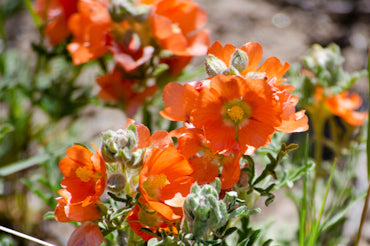The Importance of Globe Mallow Bees and Why We Should All Plant Orange Globemallow
Posted by MANDY LATCHU

The Importance of Globe Mallow Bees and Why We Should All Plant Orange Globemallow
Have you ever walked past a patch of bright orange flowers and noticed a little bee buzzing happily around? Chances are, that tiny bee could be a globe mallow bee (Diadasia diminuta), and it’s not just there for a casual visit—it’s there for survival! These hardworking pollinators have a very special relationship with a group of plants called globemallow, especially the stunning orange varieties. Let’s dive into why these bees are so important, and why planting orange globemallow could be one of the best things you can do for your garden and for nature!
Meet the Globe Mallow Bee
The globe mallow bee is a specialist bee, which means it doesn’t just stop by any flower for its pollen. It has evolved to rely on specific plants—in this case, globemallow. The bright orange blooms of globemallow serve as a lifeline for these bees, providing the pollen and nectar they need to survive. Without these flowers, globe mallow bees would struggle to thrive.
Female globe mallow bees do most of the heavy lifting when it comes to gathering pollen. They visit orange globemallow flowers, collect pollen, and bring it back to their underground nests to feed their young. It’s a busy job, but it’s all made possible by the availability of these vibrant flowers.
What About the Lone Male Bees?
Male bees have a different routine. They don’t collect pollen like the females, but they do rely on the nectar from orange globemallow flowers for energy. Plus, they’re on the lookout for mates, and where better to find a female globe mallow bee than near her favorite flowers? Male bees often hang around these blooms, sometimes even resting overnight on the plants. So, in a way, orange globemallow flowers serve as both a dining spot and a matchmaking zone for these bees!
Why Do We Need Globe Mallow Bees?
You might be wondering why we should care about these little bees. Well, bees in general are essential pollinators, and specialist bees like the globe mallow bee play a crucial role in maintaining biodiversity. By pollinating plants that other generalist bees may not visit as frequently, they help ensure that species like orange globemallow can continue to thrive. In turn, this supports a healthy ecosystem, as these plants are valuable food sources for other insects, birds, and animals.
Without bees like the globe mallow bee, the delicate balance of our ecosystem could be disrupted, which could affect the health of gardens, parks, and even farms. It’s all connected!
Why Plant Orange Globemallow?
Now that you know how important globe mallow bees are, here’s where you can help. Planting orange globemallow in your garden is a simple yet powerful way to support these bees and contribute to the health of your local ecosystem. Here’s why:
-
Food Source for Bees: The pollen and nectar of orange globemallow are essential for globe mallow bees, but other pollinators love them too! By planting them, you’re creating a mini oasis for a variety of insects.
-
Drought-Tolerant and Easy to Grow: Orange globemallow is a native plant to many arid regions and is extremely hardy. It doesn’t need a ton of water, making it perfect for sustainable gardening, especially in areas prone to drought.
-
Beautiful and Beneficial: Not only do the flowers add a splash of brilliant orange to your garden, but they also attract a host of beneficial insects, including bees and butterflies.
-
Supports Biodiversity: Planting orange globemallow helps maintain local biodiversity by providing a habitat for specialist pollinators like the globe mallow bee. The more diverse our gardens and landscapes are, the healthier they become!
How to Get Started
Ready to add a pop of color and some bee-friendly blooms to your garden? Orange globemallow is relatively easy to grow from seed or as a young plant. Here’s how you can get started:
- Find the right spot: Orange globemallow loves full sun, so plant it in a spot that gets plenty of light.
- Well-draining soil: This plant doesn’t like soggy roots, so make sure your soil is well-draining.
- Water sparingly: Once established, globemallow is drought-tolerant and doesn’t require much water, making it an eco-friendly choice.
- Enjoy the blooms: You’ll be rewarded with vibrant flowers that bloom from spring through fall, attracting not only bees but also butterflies and other beneficial pollinators.
Let’s Protect Our Pollinators
By planting orange globemallow, you’re not just adding beauty to your garden—you’re helping to sustain an entire ecosystem. The globe mallow bee, along with many other pollinators, needs your support, and it all starts with a few seeds. Let’s do our part to protect these precious bees and enjoy the stunning blooms of orange globemallow while we’re at it!
So, what are you waiting for? Let’s get planting and give our bee friends a helping hand!
